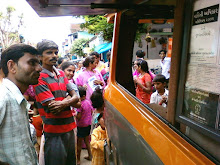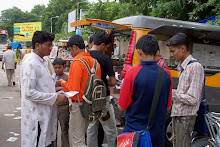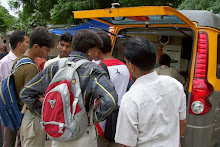Gopalkrishna Gandhi : Calcutta Telegraph : Tuesday , September 14 , 2010 :
The function of conscience should become part of everyday governance - Gopalkrishna Gandhi
Why do I say I believe this will happen? Not because I believe in sunshine, but because I believe it is better to try and quench one’s thirst — in this case the thirst for good, clean and transparent governance — with aqua pura rather than with the vinegar of cynicism.
Meanwhile, we have a National Water Mission that is doing exceedingly important work. But have Hukumat-e-Hind and the state governments really prepared Awaam-e-Hind about that grim and growing reality, very literally, Pyaas-e-Hind? Will there be water enough, 10, 15, 20 years from now, to quench drinking-water needs, farming needs and agricultural needs? I am thinking of a time when a 10-litre bamba of retailed water may cost Rs 500 or more and a litre-bottle of water between Rs 50 and Rs 100. Like the block-wise zonation of oil fields for extraction by allottee-companies, will riverbeds and river plains come to be allotted in blocks to Bisleri, Kinley, Aquafina? What will the poor do then? Drink muddied water from ponds or raid the sites of water-extraction or factories where bottled water is made, in order to ‘liberate’ them from what will surely get to be called the ‘colonization of water resources’?
Entry 18 under the state list reads: “Land, that is to say, rights in or over land, land tenures, including the relation of landlord and tenant, and the collection of rents; transfer and alienation of agricultural land; land improvement; and agricultural loans; colonization.” Colonization? Yes, the very word is used, innocently, and perhaps with settlement colonies for refugees and the like in mind, but nonetheless, there it is in our Constitution, specified as a subject-charge and therefore a prerogative and indeed, a responsibility of state governments: ‘colonization’. What is the chief characteristic of a colony? It is the loss of rights over natural resources by the people of that area and the acquiring of those rights by new entrants. Nirmalangshu Mukherji, professor, has pointed out recently that the action by the State on Vedanta is not an isolated instance of the law being upheld, there being before us the arrest of Madhu Koda, the Supreme Court’s strictures on the Bellary mines issue, the national attention paid to Posco, to the implementation of the Panchayats (Extension to Scheduled Areas) Act and the Forest Rights Act. For all these the work of civil resistance has to be acknowledged and applauded. Without that the State and the judiciary would not and could not have acted as they did.
Meanwhile, after the irony of ‘colonization’ being part of an entry in our Constitution having been missed not only by the constituent assembly but by successive Lok Sabhas, which have amended the Constitution a hundred times, and by the Constitution review commission, it is time now to amend the relevant entry in our Constitution and drop ‘colonization’ from our agenda. But more important than that is to begin to end the entry of new and dispossessing exploitations on land. And a good place to start will be by examining the contemporary relevance and role of the Land Acquisition Act and the scope of that riddle of a phrase which is at the base of the act, “public purpose”. It is fortuitous that the government of India has brought forward an amendment bill that can rectify the anomalies and injustices which that act contains and causes. Discussions on the bill must ask: Is the Land Acquisition Act of 1894 taking us unwittingly towards what is sometimes described as the Corporate State?
As they debate this very important bill, I would like to place before our lawmakers something which 52-year-old Mahatma Gandhi had to say on the subject of land acquisition by the State. The scholarly S.N. Sahu of the Rajya Sabha secretariat brought to my notice recently this remarkable statement made in 1921, when land had been acquired by the Bombay Presidency in Mulshipeta, near Poona, for a dam being built by the House of Tatas to augment the electric supply for the city of Bombay. This is probably the first instance of Section 4 of the Land Acquisition Act being used by the State, then the British raj, for a corporate project. A satyagraha was launched under Senapati Bapat by the people dispossessed. The topicality of what Gandhiji said on the occasion is surprising even today:
“My heart goes out to these poor people… I wish the great House of the Tatas, instead of standing on their legal rights, will reason with the people themselves, and do whatever they wish in consultation with them. I have some experience of Land Acquisition Acts… The dispossessed never got the exact equivalent. What is the value of all boons that the Tata scheme claims to confer upon India, if it is to be at the unwilling expense of even one poor man?… I suggest to the custodians of the great name that they would more truly advance India’s interest if they will defer to the wishes of their weak and helpless countrymen.”
Gandhi, however, is never too convenient. He says, in the very next sentence, something which those who support these rights must never forget: “…but I can never join hands with those who are ready to kill others, be it even for the cause of truth.” No wonder Maoists cannot take Gandhi.
Most civil protesters, be they sociologists, writers, academics, who have made it their task to study and espouse the cause of the dispossessed, instinctively and viscerally despise violence. They not only do not justify Maoist violence, they condemn it. I, however, do feel that some of them have underestimated the co-optive tactics of this variety of violence, which notoriously converts silence into acquiescence, receptivity into acceptance and any olive branch into a bouquet of appreciation. These individuals would have greatly enhanced their effectiveness as campaigners against the exploitation of tribal people and their rights by commercial interests if they had given the same attention to the exploitation of a whole generation of tribal people, especially tribal youth, by the violent schemata of the Maoist method.
During a recent discussion with P. Sainath on the criticality, notwithstanding the non-justiciability, of the directive principles of State policy, I discovered with some surprise that the word ‘governance’ occurs but once in the Constitution of India, and that only in the directive principles. I do not know what the significance of this is, but there it is. The directive principles, says the Constitution, shall not be enforceable by any court, “but are nevertheless fundamental in the governance of the country”. The chapter go on to say that “it shall be the duty of the State to apply these principles in making laws”.
Aruna Roy’s determined efforts with her team in Rajasthan got us the Right to Information Act. I must say that in my view, the RTI Act is the singlemost revolutionary enactment to have been made since Independence. Working for and through access, pahunch and sunvaai, the RTI is necessarily concerned with all the three sher — Awaam, Siyaasat and Hukumat. As is Nandan Nilekani’s scheme for Aadhar, officially operationalized a few days ago. This plan to unify the peoplehood of India in a national register with every individual bearing an all-purpose ‘life-number’ is fascinating for its sheer audacity. I would like to have one number, a master number, subsuming all other ones from A, B, C to Z. But it should enable me to access the Hukumat, rather than enable agencies of the Hukumat to access me. Aadhar will profit by engaging the country in a discussion on how it can be made both efficacious and conscientious.
There is a fourth leonine presence on the Lion Capital of the emperor, Asoka Devanaamapiya Piyadassi. I see this as Zameer-e-Hind — the inner life and voice of India.
Zameer-e-Hind
The directive principles of State policy are integral to it. The Supreme Court of India, the Election Commission of India, the comptroller and auditor general of India, the chief vigilance commissioner, the chief information commissioner, the National Human Rights Commission, the National Commission for Women, the National Commission for Scheduled Castes and Scheduled Tribes, the National Commission for Minorities and those bodies that parallel and mirror these in the states which also have their lokayuktas, comprise the externals of Zameer-e-Hind. And it is to them that Awaam-e-Hind looks and turns to when troubled by questions of character and conduct in Siyaasat-e-Hind and in Humukat-e-Hind. These bodies are often loosely described as constitutional authorities, and so they are. But I like to see them as institutions of conscience. In the continuing independence and fair-mindedness of these institutions of conscience, in their being ever alert, ever-responsive, self-critical, self-examining, and not self-justifying or self-exculpating, rest the self-correcting mechanisms of our State and, hence, the image and the reputation of our republic.
All the institutions of conscience that I have described as embodying Zameer-e-Hind are essentially retrospective in their operations. They identify and rectify wrongdoing. Conscience, however, is not retrospective alone. Its work is not post facto as much as it is, to borrow a phrase from grammar, in the present continuous. And Zameer-e-Hind has to be at work, to borrow a phrase from television, 24x7.
The United Progressive Alliance governments I and II have brought in some pioneering pieces of legislation, in which I would include the enactments on domestic violence, on undertrial prisoners and, of course, the RTI and the Right to Education Acts. But one legislation which has remained on the anvil for too long — not one year, not 10 years, but full 40 years — is that pertaining to the activating of the institution of lok pal. I find it interesting that no political party seems to have been over-anxious about it. It is important that this enactment be either taken forward or, if Siyaasat-e-Hind is uncomfortable with the idea of a lok pal, then Hukumat-e-Hind must tell Awaam-e-Hind why electors can be booked under common laws for graft, but not the elected.
In his farewell Republic Day address, way back in 1967, Sarvepalli Radhakrishnan spoke of “widespread inefficiency and the gross mismanagement of resources”. High-profile corruption had already performed its arangetram by then in the form of the Mundhra scandal and the defence ministry-related ‘jeep’ affair, but it had not yet broken into the tandava that we know. The erosion of a work-ethic in the institutions of governance where some do the work of ten and ten do the work of less than one was even by then a hard fact. Radhakrishnan was speaking from the highest seat of Hukumat-e-Hind, he was in fact giving a voice to Zameer-e-Hind. The fourth invisible lion on our emblem needs now to show its potential, which is also its prerogative, prospectively and powerfully. This is not something which only the institutions of conscience have to do. This is something which Hukumat-e-Hind in its daily functions must do by interiorizing Zameer-e-Hind into itself.
We all know that the national anthem was written by Tagore in a welter of conflicting emotions. The text of the official version is an abridged one. The full unabridged version, unknown to most, has the following sombre lines:
“Ghoratimiraghana nibida nishiithe piirita muurchhita deshe/... Duhswapne aatanke, rakshaa korile anke/ Snehamayi tumi maataa.”
Roughly translated, the lines invoke the benign Mother to come to the aid of our land, which is in deep darkness, which is afflicted, comatose, having nightmares of terror. The lines are not, as I said, part of our anthem, but they are part of our experience. The Awaam’s experience of its Siyaasat and of its various and successive Hukumats. But in the same excluded portion of the Jana Gana Mana text, Tagore shows a remarkable mood swing, a mood recovery with lines that are an all-time absolute favourite of mine, for they hold out hope, assurance.
The lines say, “The night will end, the dawn will break, with the sun glowing, there, far, and yet bright, on the broad forehead of the mountains on our East”: “Raatri prabhaatila udila robi-chhobi puurva udayagiri bhaale”.






























